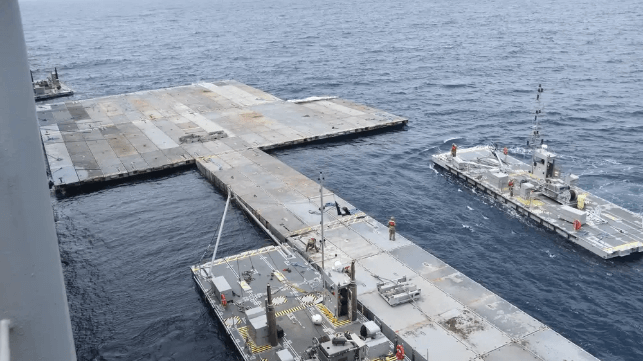Floating Pier for Gaza is Fully Assembled and Ready to Install

The White House's aid pier plan for Gaza is taking shape, and the floating causeway and offshore receiving platform are fully assembled and ready to go once weather allows, a Pentagon spokesperson said Tuesday. Rough surface conditions forced the operation to temporarily relocate to sheltered water at the Port of Ashdod, but the water-side preparatory work is now complete.
The complex operation will draw on the Joint Logistics Over The Shore capability, an Army/Navy/civilian mariner system that marries sealift with temporary port infrastructure. By setting up and using the JLOTS system, the 1,000-person team will be able to transfer food aid from a commercial sealift vessel onto a moored receiving barge out at sea; transfer the cargo onto U.S. Army landing craft; ferry the goods to a mile-long floating causeway, or "trident pier"; and then truck the food to a nearby distribution hub. The shoreside elements of the operation will not involve American servicemembers at any point, according to the White House.
"As of today, the construction of the two portions of the JLOTS — the floating pier and the Trident pier — are complete and awaiting final movement offshore," Pentagon spokeswoman Sabrina Singh said Tuesday.
A U.S.-flagged geared freighter, the Sagamore, is already in Cyprus loading food aid for the first shipment. Sagamore will unload her cargo directly onto Army trucks at the floating pier, and the trucks will carry it the rest of the way via the JLOTS infrastructure. It will not be a pure ro/ro operation, though JLOTS is capable of compatibility with ro/ro sealift.
According to the Pentagon, the system will be capable of handling 150 truckloads of food a day - though it may take a while to get up to speed. "I think what you're going to see at the very beginning is a 'crawl, walk, run' scenario," Singh said. "We're going to start with an additional small amount of aid trucks to flow in to make sure that the system works, that the distribution works, and then you'll see that increase ... when we get to full operational capacity."
Singh acknowledged a common criticism of the maritime aid corridor - that it does not have the capacity to handle Gaza's full needs. She said that cross-border trucking would be preferable, but that the maritime corridor would still help.
The territory used to get about 500 trucks a day of food aid, but the flow has been repeatedly interrupted by Israeli border controls over the past seven months. The UN says that northern Gaza is now in a state of "full-blown famine." While flows temporarily increased after unprecedented pressure from the White House, the quantities remain below the level necessary to prevent mass starvation. On Tuesday, Israel's military forces seized control of the Gazan side of the Rafah border crossing with Egypt, temporarily shutting down one of the most important routes for aid trucks.
Israel's military leadership described a policy of restricting food shipments to Gaza at the outset of the conflict, and the UN's human rights chief has suggested that this decision might be interpreted as an act of using food as a weapon of war. The International Criminal Court is widely believed to be weighing charges against both the Palestinian terrorist group Hamas and against Israeli leadership - prompting an outcry from Israel's political allies in the United States.
